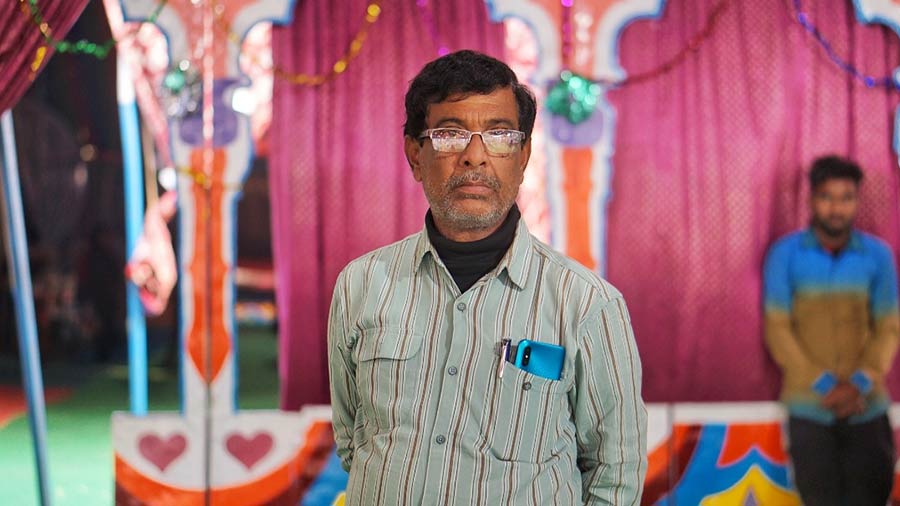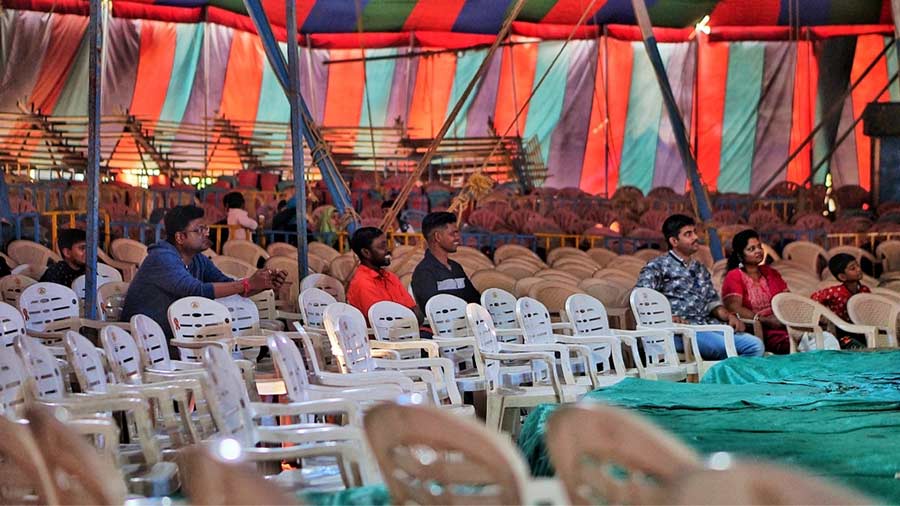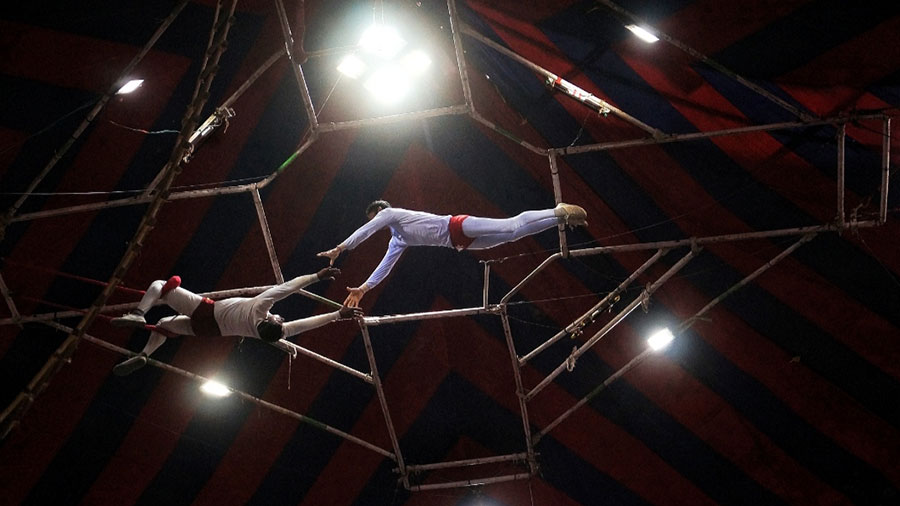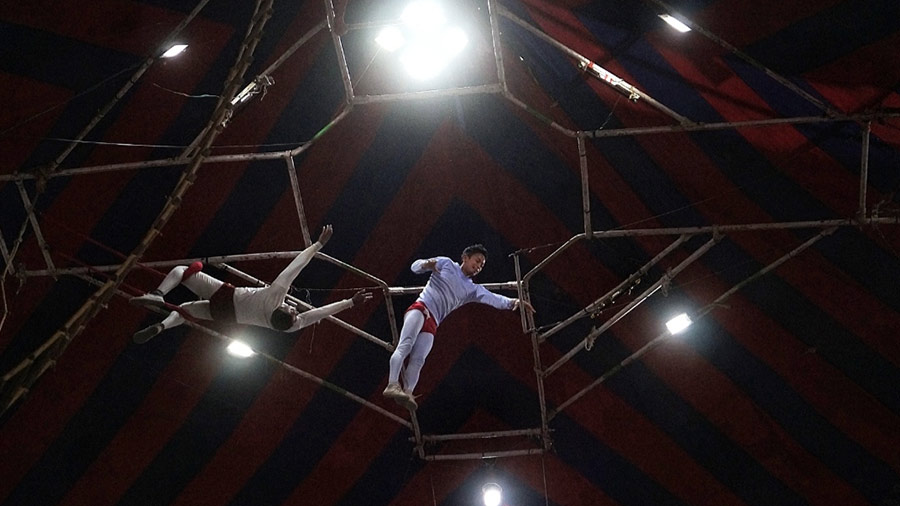Abdul Khan, 61, has been with Ajanta Circus for more than 50 years. Even today, when he enters the arena to perform his juggling act towards the beginning of the show or join the flying trapeze — the end piece and highlight of every show — he feels an excitement that can’t be matched by anything else.
Ajanta Circus has returned with regular shows after a pandemic break of two years and Khan, like the few other performers who have stayed back, couldn’t be happier.
Golden days
Most circus companies in Bengal started operating post-Independence. With tamed wild animals and foreign artistes from Russia, Africa and Europe, the circus was an annual winter celebration till the late ’90s.
“But things started changing after 2000. When wild animals were banned in the circus with the exception of elephants, and some domesticated animals like horses, dogs and some foreign birds, the circus began to lose its popularity,” said Sanjit Ghoshal, the manager of Ajanta Circus.

Sanjit Ghoshal, the manager of Ajanta Circus
Despite the ban, the circus maintained the banned animals at its own cost till 2009. Then, in 2014, elephants were also banned and West Bengal circuses shifted focus to foreign artistes from Russia, Turkey and Greece.
Then came the pandemic and lockdown in 2019 that changed everything. “The curbs on international travel forced us to stop hiring foreign artistes,” Ghoshal rued.
By that time, the audience had decreased to less than half.
Till the late ’90s, all three or four shows would have an average of 1,000 people in the audience. The number dropped to 400 between 2010 and 2018. Till last year, there were nine parrots (macaws and cockatoos) and five dogs (Indian spitz and pomeranians) that took up more than an hour of the two-and-a-half-hour show.
“And now, the government has seized all the remaining animals and birds,” Ghoshal said.

Empty seats at a recent show
Lost glory
The glitter has faded and the story behind the scenes is mostly of grime and gripe.
The downslide began in 2010 when most good artistes left the circus. Sensing that their beloved profession had no future, they started taking up other jobs to earn money. Some started pulling rickshaws and some set up paan shops. But they could never forget the golden days of the circus.
While most other circus companies had closed down during the lockdown, Ajanta Circus asked employees to stay home in exchange for a part of their salaries.
“After two years, we called everyone. Many people didn’t rejoin, but several did. It took us months to finalise the shows and get the right people for it,” Ghoshal said.

The trapeze act
Ajanta Circus has 42 artistes at present, most of them new to the profession. With only a few seniors around, there is no one to teach the newcomers.
Bappa Das joined the circus just before the pandemic. He was 19 and wanted to see the world. “After my father died I became the only breadwinner for my family in South Dinajpur. I had the option of working as a daily labourer, but I wanted to work in a circus. One of my uncles got me into it,” Bappa said. At present, he is learning different tricks, including juggling, and also doing daily chores at the circus.
Abdul Khan, now the most senior artiste at Ajanta Circus, joined the circus company when he was 10. “We used to live in South 24-Parganas. One day my brother and I bunked school to watch a film. Somehow, my father found out, slapped us on the road and asked us to go home. My brother went back, but I ran away and joined the circus company that day,” said Khan, who knows almost all the important tricks like trapezing and juggling.

Abdul Khan (left), now the most senior artiste at Ajanta Circus, joined the circus company when he was 10
Khan wanted to be a part of the magical world of the circus and see the world. After joining, he was just another staff member doing everything needed to run the shows. “Seeing my interest, the circus owner asked me to learn the art. Slowly, I started learning and went on to spend 50 years of my life in the circus,” Khan said.
Twenty years after leaving home, Khan visited his home. By that time, his brother had become a professor and both his parents had died. “My brother welcomed me as a brother should. But I could not stay at home for more than a few days. I was missing something. I returned to the circus and realised it had become my home,” he said.

‘I have spent 50 years of my life in the circus,’ Khan said
Ghoshal joined the circus because he loved to travel. In his 30-year career, Ghoshal boasts of having seen almost the entire country except Kashmir and Tripura. “Wherever the circus went, we travelled and saw the entire state. For some reason, Tripura doesn’t allow circus companies and, because of that, I couldn’t see the state. Like everyone else here, I have my family and go visit them three or four times a year,” Ghoshal said.
Changing times
With the animals gone, ringmaster Bijay, with over 40 years of experience, now takes part in the shows as a clown and juggler. Bijay had trained all sorts of wild animals, including tigers, lions, and bears, in the past and said that working with bigger animals was easier than working with birds and dogs.
“The big cats were easier to trick with food. But birds are hard to work with because they are smaller and softer. Those were the golden days. Noted bodybuilder Manohar Aich used to perform for us. Politicians and film stars would visit our tent after the show to congratulate us. Now, all that is gone,” said Bijay.
Motorcycling, juggling and trapezing are now the most popular, but only these acts can’t keep the show running. “Children kept the circus alive. They loved to see the animals and since they couldn’t visit alone, one or two parents would accompany them. Now, no children like to visit the circus,” Ghoshal said.

Motorcycling, juggling and trapezing are now the most popular, but only these acts can’t keep the show running
Business had been better at Sinthee in 2021, compared to the Patuli shows in 2022-23. “Between December 25 and January 1, we had about 400 people in each show. After that, the footfall has barely touched 100. Many people are visiting us but leaving midway because we are not being able to meet their expectations. This is a worrying situation,” said Ghoshal, adding that Rs 100 tickets are selling more than the Rs 200 and Rs 300 ones.
Future is bleak
The world of circus, according to Ghoshal, is much like club football. Players keep switching tents. So, when there were other circus companies, artistes would constantly change companies. Now, when other companies have closed down, Ajanta hardly has any competitors but times remain hard. The circus is now pinning all hopes on bringing back foreign artistes with several countries having lifted the visa ban and the Indian government offering work visas once again.
"We are expecting to hire some African artistes for our next show,” said Ghoshal. Will the crowds return to the circus? As the lights dim and the performers return to their tents, this is the question on every mind.
